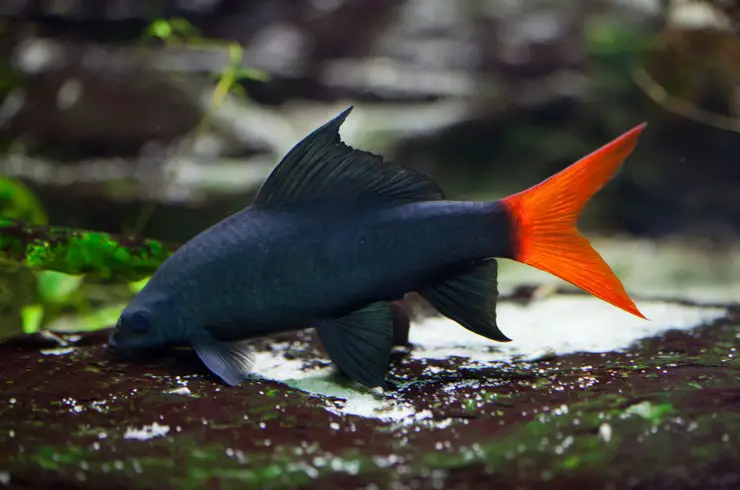The color of aquarium fish is not always monochromatic. Most often, it combines several color shades. The Labeo bicolor is one of the few bottom-dwelling fish that boasts incredibly contrasting colors: the body is jet black, the tail is bright red. In our article, we will tell you how to properly maintain this magnificent algae eater, and whether every fish will suit him as a neighbor.
General information
Lebeo bicolor, or two-color labeo (Epalzeorhynchos bicolor) is a freshwater ray-finned fish from the carp family. The native land of the species in Thailand.
The fish will be an excellent choice for aquariums over 200 liters because it has not at all miniature size (up to 15 cm) and original contrasting color. Two colors – black and red – are perfectly combined together, for which the fish received its specific epithet.
But the character of the labeo is not sugar at all: the adult representatives of the species often show aggression towards anyone who encroached on their territory, so these fish cannot be kept in cramped conditions.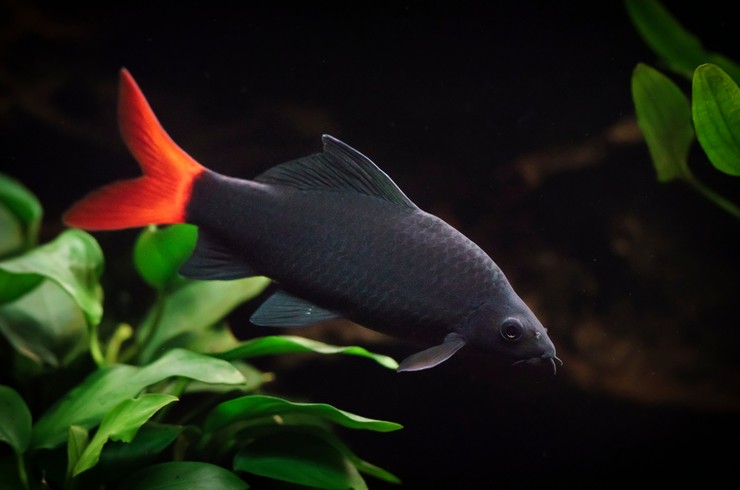
Unfortunately, the natural habitats of Labeo bicolor are under severe anthropogenic pressure. The construction of dams, water pollution by industrial and agricultural waste have led to a sharp decline in the number of Labeo two-color. This is due to both natural death and disruption of migration routes during the breeding season. It got to the point that in 1996 the species was officially declared extinct, but 18 years later, a small local population of the species was found in the Chuphraya river basin, so it received the status of “On the verge of extinction”.
Meanwhile, in the aquarium hobby, the labeo bicolor is a common fish and is found in hobbyist aquariums around the world. This species is supplied to the market from large fish farms, where the labeo is artificially bred using hormonal drugs.
Labeo bicolor is an algae eater, but rather “lazy”. Therefore, if you need a fighter against algae, then it is better to pay attention to other species – Siamese algae eater, ancistrus, girinoheilus.
Appearance
Labeo bicolor has a slender, elongated body. The size of an adult at home is usually in the range of 10-12 cm, although specimens up to 20 cm in length have been found in nature. Algal formations form the basis of the Labeo’s diet, therefore, the mouth apparatus of the fish has the shape of a sucker with horny plates. Near the mouth are two pairs of sensitive antennae.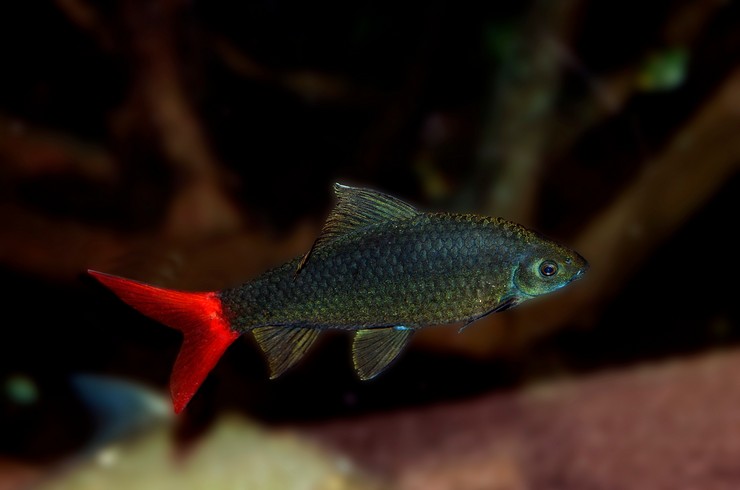
The two-colored labeo has a well-visible fin pointed at its back, which makes it look like a shark. The most attractive feature of Labeo Bicolor is its coloration. The whole body is painted velvet black and the tail is bright red. This contrast makes the fish very original. There is an albino form with a white body, red fins, and eyes.
In comfortable conditions, labeo bicolor can live up to 10 years.
Habitat
The historical homeland of Labeo Bicolor is Thailand. Previously, the species was widely represented in the Mae Klong, Chuphraya, Bangpakong rivers flowing into the Gulf of Thailand. But now there are only small surviving populations.
As a rule, the fish is found in shallow (up to 1 m depth) rivers and streams with dense thickets of living plants. The substrate is sandy, with large branches and stones. During spawning, they migrate over considerable distances to flooded areas.
Care and maintenance
Labeo bicolor is a single fish. If young individuals get along well with each other, then with age, the territoriality of the fish becomes pronounced. The minimum recommended aquarium volume is 200 liters.
The two-color labeo spends most of its life at the bottom. It is best to use sand or small pebbles as a primer, preferably with rolled edges. It is important to create as many hiding places as possible, especially if you are keeping multiple individuals. Natural driftwood, ceramic grottoes, and stones of different sizes will help you with this.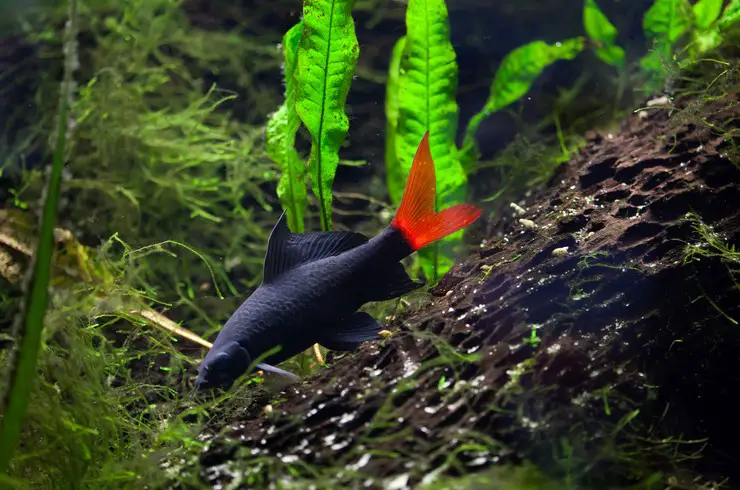
Be sure to create plots with live plants. For example, you can plant ferns or anubias.
In nature, labeo bicolor live in running water, they love clean water with a lot of oxygen. Therefore, you cannot do without a productive filter and aeration system. Once a week, replace 20% of the water with fresh water. We must not forget that tap water can be dangerous for a two-color labeo because chlorine and heavy metals are often found in it. Tetra AquaSafe conditioner will help you quickly prepare water for changes. Add 5 ml of the product for every 10 liters of water and you can safely pour it into the aquarium.
Optimal parameters for the content: T = 23-27 ° C, pH = 6.5-8.5, GH = 6-18.
Compatibility
Labeo bicolor is a very controversial fish in terms of living together with other fish species. Young individuals are quite shy, they are almost constantly hiding and do not conflict with anyone. But as they grow older, the situation changes dramatically. The territoriality of the two-color labeo increases sharply, and it begins to aggressively drive many neighbors away from its territory.
But this does not mean that labeo bicolor is not at all suitable for keeping in a common aquarium, it is just that you should be more careful when choosing neighbors.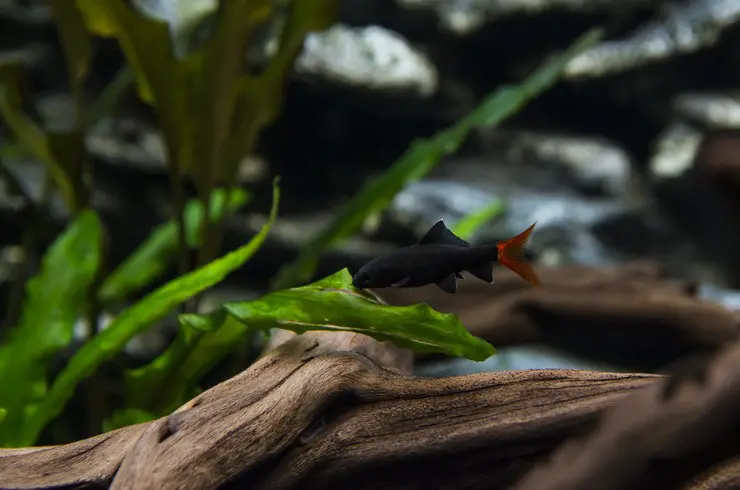
In the maximum risk zone, fish living on the bottom, for example, speckled catfish and thoracotomy. They can get seriously from an aggressive labeo. Gerinoheilus and Siamese algae eaters often find themselves in the same situation. With battles, the situation is better, but even here the possibility of conflicts cannot be completely excluded. The only thing that can smooth out the aggression is the large volume of the aquarium and a variety of different shelters.
It is best to choose medium-sized species floating in the water column as roommates. For example, barbs, iris, mollies, swordtails, tetras, scalars, congo, Malabar zebrafish are excellent choices.
Feeding labeo bicolor
By their nature, labeo two-colored are algae eaters, so it is very important that the fish have enough plant foods in their diet. Like any bottom species, labeo bicolor feeds mainly in the lower layers of the aquarium, which means that it is important that the food sinks quickly to the bottom. The healthy growth and development of fish will only be supported by balanced feeds in essential nutrients. Tetra Pleco Tablets and Tetra Wafer Mix are excellent choices for feeding Labeo Bicolor. They include spirulina algae and high-quality animal proteins to provide your fish with the most varied and nutritious food.